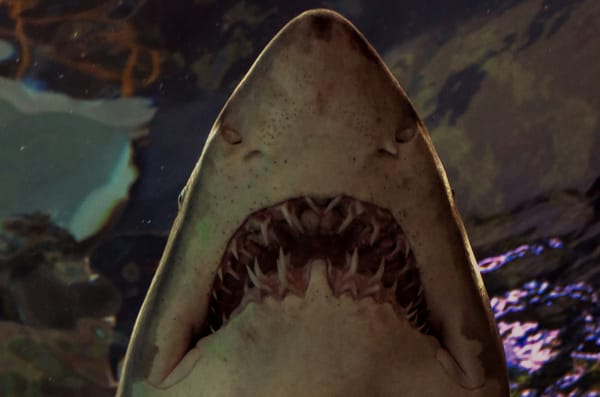The Frog Pond #14: Shady Baleen (Sarah's Version)
A 2018 study (that I found through a Tumblr post) found that humpback whales have developed a new foraging strategy to catch their prey!

Oh hi! The Frog Pond has switched from Substack to Ghost as my newsletter platform. Nothing's changed with your subscription, just make sure to add this email address to your contacts.
I switched from Substack because the platform has a lot of hate speech problems1, and I don't want to contribute my work to that kind of community.
With that, welcome to 2024 and on to the whale of the month!
Humpback whales throw shade now
A 2018 study (that I found through a Tumblr post) found that humpback whales have developed a new foraging strategy to catch their prey2. Historically these whales have eaten krill and plankton as well as anchovies, herring, salmon, and other schooling fish3 through a few hunting strategies, including one called bubble nets3.
Bubble net feeding involves one whale in a group swimming beneath the school of fish in a closing spiral, blowing bubbles in patterns to float up, taking the fish with them towards the rest of the whales. They also hunt by flick feeding, which involves a whale stunning their prey with a flick of its tail fluke on the surface of the water3.
But now some humpback whales are switching it up.
The new method, called trap-feeding, was recorded twice in 2011 and 16 times in 2015 off of Vancouver Island, which make researchers suspect that pods of whales are teaching this new technique to each other2. This is also called behavioral plasticity, the ability to learn new survival strategies in response to changes in an animal's ecosystem. Trap-feeding involves a stationary whale at, or just below, the surface and opening its mouth for 4 seconds or more while often spinning in place, with birds such as seagulls present2.
The feeding birds change how the school of fish move, making them easier to catch by staying still and waiting for the fish to come to the whale. The fish are fooled that there may be safety in the darker water shaded by the whale's huge mouth2. They may even get scooped in by the spinning flippers2!
Why would whales innovate?
The humpback whale population has change drastically since the 1960s, when the species became critically endangered by commercial whaling. Between 2003 an 2015, an increase of 771% has been documented from only 7 individuals to 61 individuals spotted annually in the Vancouver Island region2. Yay!
Lunge-feeding (what it says on the tin, lunging at schools of fish) and the other classic methods for humpback whales work best on high density prey2. The amount of energy used to do this works out because there's so many fish to feed on. But when fish schools become fewer and less dense, these methods become less effective2,3.
So with more whales in the area and less easy to scoop prey, the new trap tactic was born.
There's a great photo in the Marine Mammal Science paper on page 12 that shows the difference between a dense and scattered school of herring, and it's easy to see how the first would make sense to lunge at or bubble hunt, while the other doesn't have enough to make the effort worth the few fish you might catch.
Other shady individuals
Humpback whales aren't the first to use shade as a predatory tactic, though. Far from it! Some birds, such as the the black heron, use a tactic called canopy feeding. This involves bringing its wings up above it in the shape of an umbrella as it stalks the water. This creates enough shade that fish are attracted and caught4.
Even in the ocean, Humpback whales are not alone. The ambush star, or Stegnaster inflatus (what a name), is a starfish that uses its five arms to form a kind of canopy or gazebo structure, simulating the structure of safe coral to lure prey underneath. "[... A]s soon as the star's belly is tickled, it closes its web like the curtain of a stage, trapping the animal inside."5
A Word from a Passing Frog
Happy New Year!!
2023 was my year of querying. I sent my book to 138 agents from November 2022 until September 2023. I got 135 rejections and more requests than I'd ever thought I would when I'd aimed to at least get 100 rejections. I learned a ton about the industry, resilience, and how much ice cream I can eat after a stinging rejection. I also learned how much I truly believed in this book, and in myself, as corny as that sounds. And I learned how many nos it took to get my yes, because--
2023 was also the year I got my agent!!! Larissa has been phenomenal to work with over the past few months while we make my maritime gothic horror book, Lighthouse, the best it can be before we send it on submission. Ahh!!!
2023 was full of practice. I worked on 4 different projects while querying Lighthouse: Bachelor Hell, a contemporary horror-satire; Hellmouth, a Historical Gothic Horror; TIE, a Sci-Fi Eco-Horror; and Apothecary, a Dark Academia Fantasy. These projects helped me hone my voice after discovering it with Lighthouse in 2022.
2023 was the most challenging year I've ever had, but also the most rewarding. My SO finished his PhD, we moved back to our hometown for his Postdoc and our sanity, I dealt with some major bouts of depression, and I quit my 5-year day job at the end of December. And we adopted a cat!!

2024 feels full of possibility. Going on submission, searching for a new day job, and choosing my next project to work on. All of this is scary! A "you're at the top of the rollercoaster and you're about to go over the hill" kind of thrill in the pit of your stomach. I'm flip-flopping between excitement and dread at all the change that may be coming my way.
I'm a catastrophizer so I tend to dread this kind of moment in my life, not knowing the shape of the next few years or even months. But I'm learning (slowly) to get more comfortable with not knowing what's next. (Also I'm going to see the Eras tour in July and cannot wait!!)
While I've had a great year personally, it's been a hard one to stomach for our world. I hope the new year can bring freedom, justice, peace, ceasefires, and the comfort which all people have a fundamental right to for the people of Palestine, DR Congo, Sudan, Niger, Somalia, Yemen, Armenia, and many other states fighting against colonial genocide6. I've got some resources at the bottom of the footnotes as a first step for anyone who wants to learn more. It's pretty clear from my newsletter that I value digging into sources. That doesn't end at silly starfish or subterranean forests.
Favourite books of 2023
I wish I'd read more!! I finished 27 books/fiction podcasts and DNF'd 11 more. I found some real gems though in this year's list:
Best Non-Fiction: Underland: A Deep Time Journey by Robert Macfarlane
The most narratively captivating non-fiction book I've ever read. Whether or not you love fungi or ossuaries or deep salt mines, you will find this engaging.
Best Debut: I Feed Her to the Beast and the Beast Is Me by Jamison Shea
A stunning contemporary horror novel about ruthlessness, the intersection of racism and classism, and falling in love with monstrosity. I loved this book so much. If you're a fan of cosmic horror, ballet, and/or want a book that makes you both grin and squirm at the same time, check it out! I can't wait for the sequel.
Best Overall Favourite: Our Wives Under the Sea by Julia Armfield
Listen. You give me underwater horror, sapphic complex dynamics, and beautiful prose and I am all in. If you're a fan of eco-horror or want to try it, this is a great place to start (and at 240 pages, pretty short!).
Books I'm particularly looking forward to reading in 2024:
- The Cure for Drowning by Loghan Paylor*
- House of Hunger by Alexis Henderson
- Linghun by Ai Jiang
- The Overstory by Richard Powers
- Whalefall by Daniel Kraus
- Last to Leave the Room by Caitlin Starling
- Our Share of Night by Mariana Enriquez
- Here Lies a Vengeful Bitch by Codie Crowley*
- Curious Tides by Pascale Lacelle
- So Let Them Burn by Kamilah Cole*
*Coming out in 2024, go pre-order if you're interested in them!
Footnotes
4: David Attenborough (1998). Life of Birds. BBV. pp. 122–123
5: https://www.seafriends.org.nz/images/urchin.htm
6:
- STANDING IN SOLIDARITY WITH OUR SIBLINGS IN PALESTINE, SUDAN, THE DEMOCRATIC REPUBLIC OF CONGO AND YEMEN, AGAINST CONTINUED COLONISATION: https://racialjusticenetwork.co.uk/standing-in-solidarity-with-our-siblings-in-palestine-sudan-the-democratic-republic-of-congo-and-yemen-against-continued-colonisation/,
- All the Walls Will Fall: 2023 Palestine Liberation Resource List: https://docs.google.com/document/d/1ol9GjNwTo99mPzXnRgL0ZLvs-fw0vc6MEPBJhuJHtbo/edit,
- Silent genocides: Congo, Armenia + Sudan: https://migrantsrights.org.uk/2023/11/07/silent-genocides/,
- Jewish Voice For Peace: https://www.jewishvoiceforpeace.org/news/,
- Palestine 101: https://decolonizepalestine.com/introduction-to-palestine/
- The Hundred Years' War on Palestine: A History of Settler-Colonial Conquest and Resistance, 1917-2017: https://www.goodreads.com/book/show/41812831-the-hundred-years-war-on-palestine (I'm just finishing this book and it's a great primer on the historical, global politics involved in the colonization of Palestine.)





